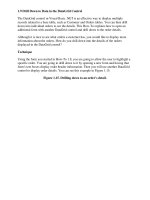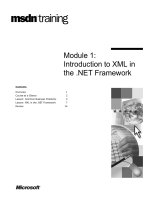FTTH COMMUNICATIONS DEFERS CAPEX CLOSER TO REVENUE IN THE PON
Bạn đang xem bản rút gọn của tài liệu. Xem và tải ngay bản đầy đủ của tài liệu tại đây (249.15 KB, 4 trang )
CASE STUDY
FTTH COMMUNICATIONS DEFERS CAPEX
CLOSER TO REVENUE IN THE PON
SITUATION
FTTH Communications is an integrated provider of voice, video and
Internet services in Minneapolis. Delivering services to residential and
business customers on an all-fiber network, the FTTH Communications
business plan depends upon a combination of low costs, exceptional
service, and leading-edge technology to increase both the number of
subscribers and overall subscriber satisfaction.
Company managers had seen from other fiber-to-the-home projects
around the country how varying take-rates can impact profitability and
drain capital from more productive uses, such as creation of advanced
services. The challenge was to create an infrastructure that maintains
capital expenditure as close as possible to revenue generation while, at
the same time, offering reduced operating expenses, so that investment
in new services is possible.
CASE STUDY
SOLUTION
The solution was based in both architecture and
supporting products. FTTH Communications
found that the optimum architecture was a
passive optical network (PON) with passive
splitters centralized in Fiber Distribution Hubs
(FDH). Splitters were specified 1x32 to mirror
port capacity on optical line terminal (OLT) cards
in the headend data center. With no splitters at
Access Terminals (AT) closer to the homes, FTTH
Communications has been able to maximize port
usage on expensive OLT cards.
To illustrate, the company uses four-port OLT cards
in the data center. Each port supports 32 homes,
each OLT card supporting a total of 128 homes.
Each neighborhood is supported by its own FDH,
up to 1,152 homes. The first 32 subscribers in the
neighborhood are connected to the same 1x32
splitter in the FDH. This splitter is supported by
OLT card #1 in the data center. When the 33rd
subscriber is added, the next splitter in the FDH
is put to use, which then makes use of port two
on OLT card #1. Only when the 129th subscriber
signs-up for service is there a requirement to
purchase and turn-up service on OLT card #2 in
the data center.
This architecture of centralized splitters effectively
defers capital expense closer to revenue
generation. The alternative architecture—placing
splitters in both FDHs and ATs—is an expensive
proposition. In the above example, 128
subscribers from 1,152 homes are served with
one OLT card when splitters are centralized in
the FDH. Yet with splitters in both FDHs and ATs,
additional OLT cards are required in the data
center, resulting in subscribers being spread out
across more OLT cards than would be needed
for the customer count. In fact, with any take-
rate below 100%, there would always be
underutilized and stranded ports on expensive
OLT cards when splitters are placed in both FDHs
and ATs.
The FDH also offers the added benefit of lower
costs for service turn-up because connectors, not
splices, are used to add subscribers and services.
As the business grows, FTTH Communications will
realize operational savings because service turn-
up can be done faster and with less-skilled, less-
expensive technicians.
Still, the main benefit of the ADC solution is
mirroring OLT port capacity with 1x32 splitters in
centralized, high-density, technician-friendly Fiber
Distribution Hubs. This centralized 1x32 splitter
architecture, enabled by the design of the FDH,
delays capital investment in outside plant and
allows more investment in leading edge services
for subscribers.
IMPLEMENTATION
“There is a problem with distributed splitting,”
said John Schultz, General Manager, FTTH
Communications, referring to an architecture
that places splitters at Access Terminals. “Too
much money is spent putting fiber in the ground
and there is huge underutilization of electronics
at the headend,” he said. With initial builds,
FTTH Communications had placed splitters in
ATs and FDHs and turned-up service with splices,
a deployment strategy that proved costly to
implement. “Customer acquisition is never logical.
Placing splitters in ATs was wasted capital and
made service turn-up a more expensive process,”
said Schultz.
A close-up of this FDH shows room for seven more
1x32 splitters. Distribution cable is safely terminated
in a “parking lot” until a subscriber is activated.
Service turn-up requires mating connectors rather than
splicing, moving a connectorized distribution cable
from the parking lot to the connectorized distribution
field. In this new FDH, one subscriber is activated,
shown by the vacant spot in the parking lot and the
labeled distribution cable.
CASE STUDY
From those early lessons, FTTH found that
centralizing splitters in FDHs was more cost
effective from a capital and operating perspective.
Yet while several vendors offered a centralized
fiber distribution hub with 1x32 splitters, unique
features of the FDH swayed the purchase decision
to ADC.
ADC’s FDH offers segregated areas for splice and
storage of feeder fiber and distribution fiber. In
addition, each splitter output port is terminated
with a fiber jumper that retains the dust cap on
the open connector, which is stored in a protected
area of the cabinet. Connectorized tail-ends of
distribution cables are also stored in a protected
area. Integral cable management throughout
the FDH ensures not just proper routing within
the cabinet but also proper storage that protects
fibers from damage and enables increased density.
In fact, FTTH Communications is in the process of
replacing one older cabinet that was configured
with splitters with no fiber cable management.
“We wanted to eliminate failure points in the
network. Housing splitters, distribution cable
and feeder cable in a cabinet without fiber
management was just a bad design. We know
that proper fiber management means less issues
to deal with,” said Schultz.
With this cabinet design, service turn-up now
requires mating connectors rather than splicing.
Use of connectors in the FDH gives FTTH
Communications a build-as-you-grow network.
It is a cross-connect solution that allows easy
addition of subscribers and installation of
headend electronics in parallel with growth.
“It is really bad to put so much money upfront
without revenue to cover it. This is the right
architecture and the right product to support
the architecture. From a financial, engineering
and operational standpoint, we’ve got the best
solution available,” said Schultz.
Schultz figured that the practical and logical
design of the FDH would show returns over
the years in terms of speed of service turn-up,
reduced costs for service turn-up, and higher
reliability of the PON. Yet the value of the FDH
became apparent before the first subscriber was
put in service.
“Our initial deployment was a very simple
installation,” said Schultz. “Splicing was self-
explanatory, as was fiber routing and storage.
This was one reason we chose ADC—they are
leaders in fiber cable management,” he said.
Even documentation missing from the first FDH
shipped to FTTH Communications caused no
issues with installation. “The guys really got it.
This was a brand new product for them yet the
whole installation went very smoothly,” said
Schultz.
CONCLUSION
FTTH Communications found in ADC a partner
with the same goals—drive out costs and
push capital expenditure off as far as possible.
These were the design objectives of the FDH.
Yet the main benefits that accrue to FTTH
Communications come from satisfied subscribers,
according to Schultz. “If you construct the outside
plant in the right way, you can really drive costs
down. This is allowing us to spend capital on new
technologies for subscribers, such as video on
demand and interactive TV. We spend less on the
outside plant so we can spend more on services,”
said Schultz.
“If you construct the outside plant
in the right way, you can really
drive costs down. This is allowing
us to spend capital on new
technologies for subscribers.”
Web Site: www.adc.com
From North America, Call Toll Free: 1-800-366-3891 • Outside of North America: +1-952-938-8080
Fax: +1-952-917-3237 • For a listing of ADC’s global sales office locations, please refer to our Web site.
ADC Telecommunications, Inc., P.O. Box 1101, Minneapolis, Minnesota USA 55440-1101
Specifications published here are current as of the date of publication of this document. Because we are continuously
improving our products, ADC reserves the right to change specifications without prior notice. At any time, you may
verify product specifications by contacting our headquarters office in Minneapolis. ADC Telecommunications, Inc.
views its patent portfolio as an important corporate asset and vigorously enforces its patents. Products or features
contained herein may be covered by one or more U.S. or foreign patents. An Equal Opportunity Employer
103776AE 11/06 Revision © 2004, 2006 ADC Telecommunications, Inc. All Rights Reserved
CASE STUDY









